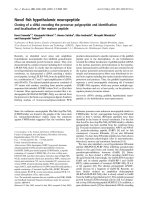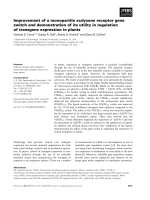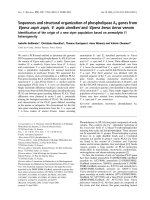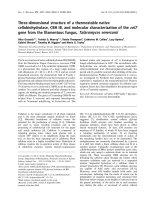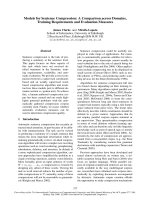EXISTENCE OF A POSITIVE SOLUTION FOR A p-LAPLACIAN SEMIPOSITONE PROBLEM MAYA CHHETRI AND R. SHIVAJI docx
Bạn đang xem bản rút gọn của tài liệu. Xem và tải ngay bản đầy đủ của tài liệu tại đây (459.91 KB, 5 trang )
EXISTENCE OF A POSITIVE SOLUTION FOR A p-LAPLACIAN
SEMIPOSITONE PROBLEM
MAYA CHHETRI AND R. SHIVAJI
Received 30 September 2004 and in revised form 13 January 2005
We consider the boundary value problem −∆
p
u = λf(u)inΩ satisfying u = 0on∂Ω,
where u = 0on∂Ω, λ>0isaparameter,Ω is a bounded domain in R
n
with C
2
boundary
∂Ω,and∆
p
u := div(|∇u|
p−2
∇u)forp>1. Here, f :[0,r] → R is a C
1
nondecreasing
function for some r>0 satisfying f (0) < 0 (semipositone). We establish a range of λ
for which the above problem has a positive solution when f satisfies certain additional
conditions. We employ the method of subsuper solutions to obtain the result.
1. Introduction
Consider the boundary value problem
−∆
p
u = λf(u)inΩ,
u>0inΩ,
u
= 0on∂Ω,
(1.1)
where λ>0isaparameter,Ω is a bounded domain in
R
n
with C
2
boundary ∂Ω and
∆
p
u := div(|∇u|
p−2
∇u)forp>1. We assume that f ∈ C
1
[0,r] is a nondecreasing func-
tion for some r>0suchthat f (0) < 0 and there exist β ∈ (0,r)suchthat f (s)(s − β) ≥ 0
for s ∈ [0,r]. To precisely state our theorem we first consider the eigenvalue problem
−∆
p
v = λ|v|
p−2
v in Ω,
v = 0on∂Ω.
(1.2)
Let φ
1
∈ C
1
(Ω) be the eigenfunction corresponding to the first eigenvalue λ
1
of (1.2)
such that φ
1
> 0inΩ and φ
1
∞
= 1. It can be shown that ∂φ
1
/∂η < 0on∂Ω and hence,
depending on Ω, there exist positive constants m,δ,σ such that
∇φ
1
p
− λ
1
φ
p
1
≥ m on Ω
δ
,
φ
1
≥ σ on Ω \ Ω
δ
,
(1.3)
where Ω
δ
:={x ∈ Ω | d(x,∂Ω) ≤ δ}.
Copyright © 2006 Hindawi Publishing Corporation
Boundary Value Problems 2005:3 ( 2005) 323–327
DOI: 10.1155/BVP.2005.323
324 Positive solution for p-Laplacian semipositone problems
We will also consider the unique solution, e ∈ C
1
(Ω), of the boundary value problem
−∆
p
e = 1inΩ,
e = 0on∂Ω
(1.4)
to discuss our result. It is known that e>0inΩ and ∂e/∂η < 0on∂Ω. Now we state our
theorem.
Theorem 1.1. Assume that there exist positive constants l
1
,l
2
∈ (β,r] satisfying
(a) l
2
≥ kl
1
,
(b) | f (0)|λ
1
/m f (l
1
) < 1,and
(c) l
p−1
2
/f(l
2
) >µ(l
p−1
1
/f(l
1
)),
where k = k(Ω)= λ
1/(p−1)
1
(p/(p − 1))σ
(p−1)/p
e
∞
and µ= µ(Ω)= (pe
∞
/(p − 1))
p−1
(λ
1
/
σ
p
). Then there exist
ˆ
λ<λ
∗
such that (1.1)hasapositivesolutionfor
ˆ
λ ≤ λ ≤ λ
∗
.
Remark 1.2. A simple prototype example of a function f satisfying the above conditions
is
f (s) = r
(s +1)
1/2
− 2
;0≤ s ≤ r
4
− 1 (1.5)
when r is large.
Indeed, by taking l
1
= r
2
− 1andl
2
= r
4
− 1 we see that the conditions β(= 3) <l
1
<l
2
and (a) are easily satisfied for r large. Since f (0) =−r,wehave
f (0)
λ
1
mf
l
1
=
λ
1
m(r − 2)
. (1.6)
Therefore (b) will be satisfied for r large. Finally,
l
p−1
2
/f(1
2
)
l
p−1
1
/f(l
1
)
=
r
4
− 1
p−1
(r − 2)
r
2
− 1
p−1
r
2
− 1
∼
r
4p−3
r
2p
∼ r
2p−3
(1.7)
for large r and hence (c) is satisfied when p>3/2.
Remark 1.3. Theorem 1.1 holds no matter what the growth condition of f is, for large
u.Namely, f could satisfy p-superlinear, p-sublinear or p-linear growt h condition at
infinity.
It is well documented in the literature that the study of positive solution is very chal-
lenging in the semipostone case. See [5] where positive solution is obtained for large λ
when f is p-sublinear at infinity. In this paper, we are interested in the existence of a
positive solution in a range of λ without assuming any condition on f at infinity.
We prove our result by using the method of subsuper solutions. A function ψ is said
to be a subsolution of (1.1)ifitisinW
1,p
(Ω) ∩ C
0
(Ω)suchthatψ ≤ 0on∂Ω and
Ω
|∇ψ|
p−2
∇ψ ·∇w ≤
Ω
λf(ψ)w ∀w ∈ W, (1.8)
M. Chhetri and R. Shivaji 325
where W ={w ∈ C
∞
0
(Ω) | w ≥ 0inΩ} (see [4]). A function φ ∈ W
1,p
(Ω) ∩ C
0
(Ω)issaid
to be a supersolution if φ ≥ 0on∂Ω and satisfies
Ω
|∇φ|
p−2
∇φ ·∇w ≥
Ω
λf(φ)w ∀w ∈ W. (1.9)
It is known (see [2, 3, 4]) that if there is a subsolution ψ and a supersolution φ of (1.1)
such that ψ ≤ φ in Ω then (1.1)hasaC
1
(Ω)solutionu such that ψ ≤ u ≤ φ in Ω.
For the semipositone case, it has always been a challenge to find a nonnegative subso-
lution. Here we employ a method similar to that developed in [5, 6] to construct a positive
subsolution. Namely, we decompose the domain Ω by using the properties of eigenfunc-
tion corresponding to the first eigenvalue of −∆
p
with Dirichlet boundary conditions to
construct a subsolution. We will prove Theorem 1.1 in Section 2.
2. Proof of Theorem 1.1
First we construct a positive subsolution of (1.1). For this, we let ψ = l
1
σ
p/(1−p)
φ
p/(p−1)
1
.
Since ∇ψ = p/(p − 1)l
1
σ
p/(1−p)
φ
1/(p−1)
1
∇φ
1
,
Ω
|∇ψ|
p−2
∇ψ.∇w
=
p
p − 1
l
1
σ
p/(1−p)
p−1
Ω
φ
1
∇φ
1
p−2
∇φ
1
·∇w
=
p
p − 1
l
1
σ
p/(1−p)
p−1
Ω
∇φ
1
|
p−2
∇φ
1
∇
φ
1
w
− w∇φ
1
=
p
p − 1
l
1
σ
p/(1−p)
p−1
Ω
∇φ
1
p−2
∇φ
1
.∇
φ
1
w
−
p
p − 1
l
1
σ
p/(1−p)
p−1
×
Ω
∇φ
1
p
w
=
p
p − 1
l
1
σ
p/(1−p)
p−1
Ω
λ
1
φ
1
p−2
φ
1
φ
1
w
−
p
p − 1
l
1
σ
p/(1−p)
p−1
×
Ω
|∇φ
1
|
p
w
by (1.2)
=
p
p − 1
l
1
σ
p/(1−p)
p−1
Ω
λ
1
φ
1
p
−
∇φ
1
p
w ∀w ∈ W.
(2.1)
Thus ψ is a subsolution if
p
p − 1
l
1
σ
p/(1−p)
p−1
Ω
λ
1
φ
p
1
−
∇φ
1
p
w ≤ λ
Ω
f (ψ)w. (2.2)
326 Positive solution for p-Laplacian semipositone problems
On Ω
δ
∇φ
1
p
− λφ
p
1
≥ m (2.3)
and therefore
p
p − 1
l
1
σ
p/(1−p)
p−1
λ
1
φ
p
1
−
∇φ
1
p
≤−m
p
p − 1
l
1
σ
p/(1−p)
p−1
≤ λf(ψ) (2.4)
if
λ ≤
˜
λ :=
m
p/(p − 1)
l
1
σ
p/(1−p)
p−1
f (0)
. (2.5)
On Ω \ Ω
δ
we have φ
1
≥ σ and therefore
ψ = l
1
σ
p/(1−p)
φ
p/(p−1)
1
≥ l
1
σ
p/(1−p)
σ
p/(p−1)
= l
1
. (2.6)
Thus
p
p − 1
l
1
σ
p/(1−p)
p−1
λ
1
φ
p
1
−
∇φ
1
p
≤ λf(ψ) (2.7)
if
λ ≥
ˆ
λ :=
λ
1
p/(1 − p)l
1
σ
p/(1−p)
p−1
f
l
1
. (2.8)
We get
ˆ
λ<
˜
λ by using (b). Therefore ψ is a subsolution for
ˆ
λ ≤ λ ≤
˜
λ.
Next we construct a supersolution. Let φ = l
2
/(e
∞
)e.Thenφ is a supersolution if
Ω
∇φ
p−2
∇φ.∇w =
Ω
l
2
e
∞
p−1
w ≥ λ
Ω
f (φ)w ∀w ∈ W. (2.9)
But f (φ) ≤ f (l
2
) and hence φ is a super solution if
λ ≤ λ :=
l
p−1
2
e
p−1
∞
f
l
2
. (2.10)
Recalling (c), we easily see that
ˆ
λ<λ. Finally, using (2.1), (2.9) and the weak comparison
principle [3], we see that ψ ≤ φ in Ω when (a) is satisfied. Therefore (1.1) has a positive
solution for
ˆ
λ ≤ λ ≤ λ
∗
where λ
∗
= min{
˜
λ,λ}.
M. Chhetri and R. Shivaji 327
References
[1] M. Chhetri, D. D. Hai, and R. Shivaji, On positive solutions for classes of p-Laplacian semipositone
systems, Discrete Contin. Dynam. Systems 9 (2003), no. 4, 1063–1071.
[2] P. Dr
´
abek and J. Hern
´
andez, Existence and uniqueness of positive solutions for some quasilinear
elliptic problems, Nonlinear Anal. Ser. A: Theory Methods 44 (2001), no. 2, 189–204.
[3] P. Dr
´
abek, P. Krej
ˇ
c
´
ı, and P. Tak
´
a
ˇ
c, Nonlinear Differential Equations, Chapman & Hall/CRC Re-
search Notes in Mathematics, vol. 404, Chapman & Hall/CRC, Florida, 1999.
[4] Z.M.GuoandJ.R.L.Webb,Large and small solutions of a class of quasilinear elliptic eigenvalue
problems,J.Differential Equations 180 (2002), no. 1, 1–50.
[5] D.D.HaiandR.Shivaji,An existence result on positive solutions for a class of p-Laplacian systems,
Nonlinear Anal. 56 (2004), no. 7, 1007–1010.
[6] S. Oruganti and R. Shivaji, Existence results for classes of p-Laplacian semipositone equations,
submitted.
Maya Chhetri: Department of Mathematical Sciences, University of North Carolina at Greensboro,
NC 27402, USA
E-mail address:
R. Shivaji: Department of Mathematics and Statistics, Mississippi State University, Mississippi
State, MS 39762, USA
E-mail address:



